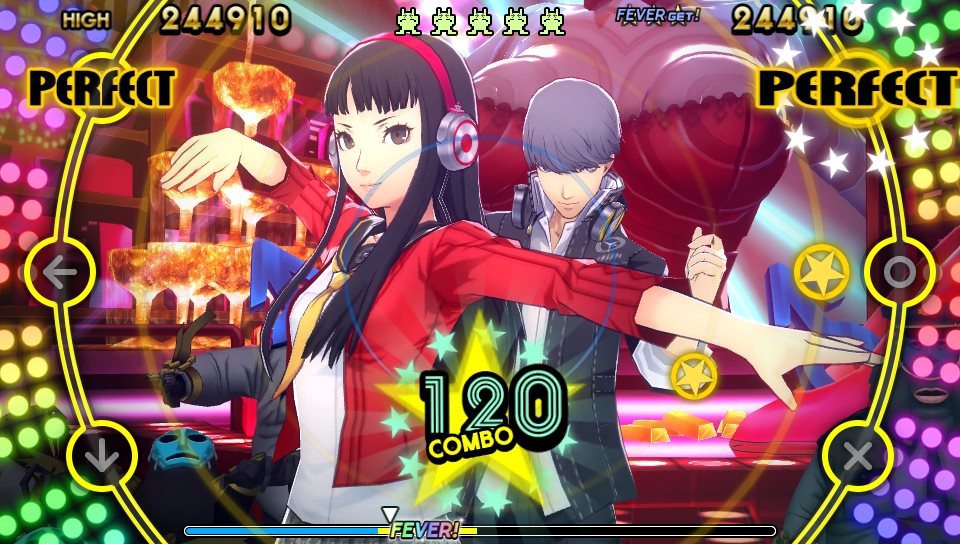As I started up Persona 4: Dancing All Night, I immediately heard the music from the Velvet Room pour out of my Vita’s speakers. Jumping back into the world of Persona is like running into a friend you haven’t seen for quite some time – the memories come rushing back and it’s almost too much to bear bare.
Dancing All Night is a love-letter to fans of the game’s predecessor, Persona 4. Familiar faces, tunes and banter between characters greet players throughout the game’s 10 hour story mode, retaining that classic Persona feeling (bonus: all spoken dialogue is voiced). Whether it’s Kanji still ripping on Chie’s abysmal cooking or the familiar twinkle of the piano keys as the investigation teams gathers clues to solve a case, it truly feels like a continuation of its parent game.
The story itself takes place six months after the events of Persona 4, and those who played through that title on PS2 or on Vita will immediately feel comfortable with Dancing All Night’s premise. Six months after the events of P4, Rise Kujikawa is set to return to superstardom with a performance at the Love Meets Bond Festival, where Yu Narukami and Naoto Shirogane have joined as her backup dancers. During a late-night practice, Naoto mentions a rumor is circulating that states “at midnight, if you see a video of a deceased idol playing on the LMB site, you are transported to the ‘other side’ and will never wake up again.”
The trio take a look at the website and are indeed transported to the ‘Midnight stage’ to encounter hoards of shadows as they did previously when they ventured to the ‘Midnight channel’ in P4. A strange voice reveals violence is not possible in this end of the world, leading Yu to learn the only way to break the shadows’ control is through dance to summon a persona. A fellow group of female idols, “Kanimin Kitchen” is also set to perform at the LMB festival, but also end up taken to the ‘Midnight stage,’ leading to the rest of the investigation team traveling from Inaba to find themselves set to solve another case together.

The story, while it obviously doesn’t become as fleshed out as the main title’s, still remains interesting and fun as it plays out. Just like its predecessor, it strikes a nice balance of light, humorous moments, while simultaneously presenting those deep life-lessons that Persona executes so well. Its major themes of bonds of friendship and being true to yourself appropriately tug at the heart strings of anyone who feels connected to the characters involved. The number of Persona 4 references will delight veteran players (“Bring on the ‘cubstep,'”says Teddie), but the game also does a fine job of introducing basic details and character backgrounds for those who may pick up the game that have never played a Persona title before.
While the game takes a little while to introduce you to your first dance (dialogue takes up a good part of the story’s first hour), a short tutorial teaches you the basics and you’re all set to begin dancing. Six buttons – three on each side of the screen – correspond to the d-pad and selection buttons on the Vita, acting as your main way of pressing to maintain the rhythm combos that emerge from the center of the screen. As they pass over the arrows or symbols, timing a press to the beat correctly will merit you a “Perfect!” or “Great!” rating that will keep the audience entertained, ultimately preventing you from failing a song, while pushing either joystick when a large ring reaches the outer circle fills up your fever combo meter, leading to a partner joining you to dance on stage.
The soundtrack of Persona 4: Dancing All Night is filled with strong and varied Persona tunes, and throughout the story mode, players have a chance to dance as a ton of characters ranging from Yu to Teddie to Nanako. Each character graces the screen while you play their song, but unfortunately, these dancing animations become way too chaotic and flashy, occasionally making it difficult to see and keep up with the emerging rhythm patterns, resulting in a miss that ruins your 200+ combo. It’s a minor flaw, but as it occurs during the main portion of gameplay, it can make dancing a little frustrating.

I never found the story mode to be challenging, but after the story’s 7.5 chapters (chapter 8 is merely a post-credits cutscene), a nice chunk of time can be spent in Free Dance mode, where you can select a difficulty, track, costume (!) and dance partner of your preference. The more you dance, the more you unlock, and the more items and costumes you’ll be able to purchase with in-game currency through the game’s shopping menu. This section adds a nice amount of replay ability for those looking to grab everything that the game offers.
While Persona 4: Dancing All Night is now the only Persona title that will see a release this fall, it’s one that is absolutely worth your time. Whether it’s your first dive into the world of Persona, or if you’ve been waiting all year to dance with Yu and the gang, Persona 4: Dancing All Night is an admirable addition to your Vita library.

